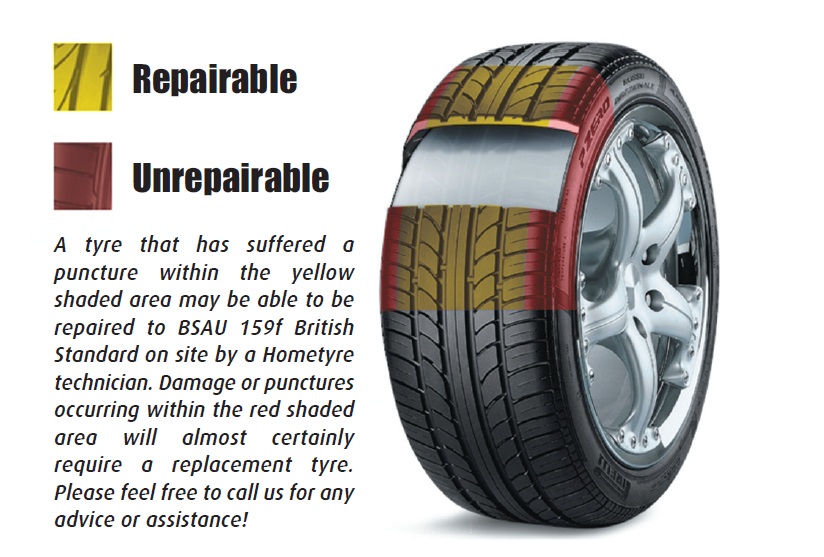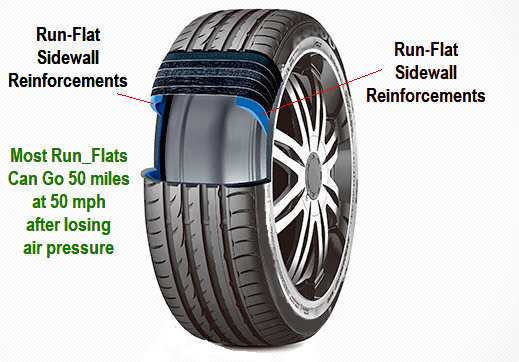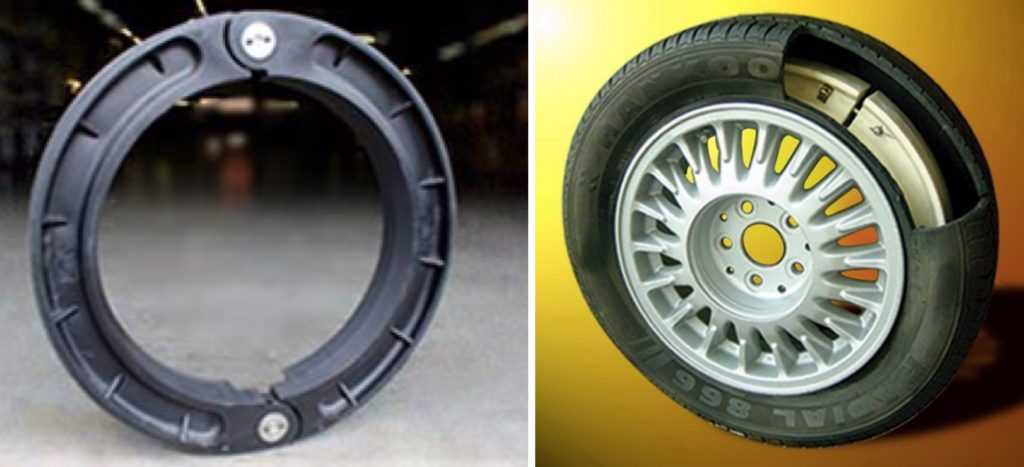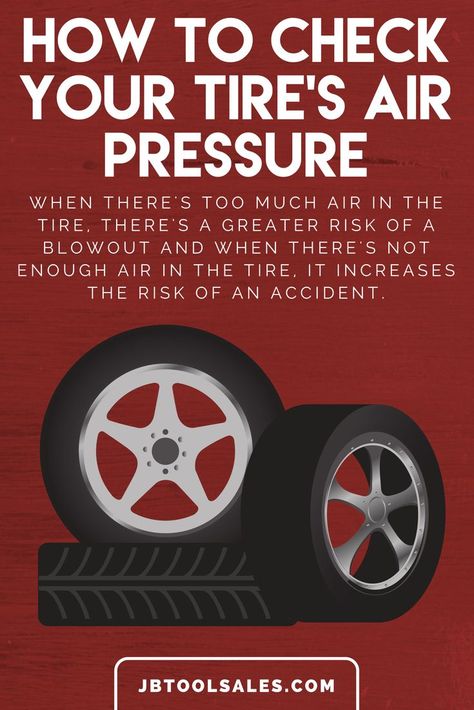The majority of newer cars are now equipped with run flat tyres as standard. Run flat tyre technology gives you the ability to keep driving on a tyre with low pressure or a puncture for an additional 50 miles at speeds up to 50mph.
Bridgestone's revolutionary run flat technology, ROF (RunOnFlat), RFT (Run flat tyre) or RSC (Run-flat System Component) was developed with a thinner sidewall than other run flat tyres. This technology guarantees enhanced comfort levels when driving.
Dueler H/P Sport
Prices from £111.44 View all sizes
Potenza RE050A
Prices from £101.09 View all sizes
Potenza S001
Prices from £80. 34 View all sizes
Turanza T005
Prices from £78.28 View all sizes
Continental developed their SSR (self-supporting run flat) technology for low section tyres that can fit all standard rims. Continental run flat tyres are available in the treads below.
ContiPremiumContact 6
Prices from £79.93 View all sizes
ContiSportContact 5
Prices from £97.95 View all sizes
EcoContact 6
Prices from £64. 16 View all sizes
16 View all sizes
SportContact 6
Prices from £132.95 View all sizes
Dunlop offers a range of run flat tyres available with ROF (RunOnFlat) and DSST (Dunlop Self-Supporting Technology). Run flat tyres are developed with a special compound that allows more flexibility in the tyre for a more comfortable drive than other run flats.
SP SportMaxx GT
Prices from £145.66 View all sizes
SP SportMaxx RT
Prices from £92.95 View all sizes
SP SportMaxx RT2
Prices from £99. 54 View all sizes
54 View all sizes
Goodyear run flat tyres feature the ROF (Run on Flat) and EMT (Extended Mobility Technology). Developed with convenience in mind, these run flat tyres are available for a range of tyre types and sizes.
Eagle F1 Asymmetric 3
Prices from £97.99 View all sizes
Eagle F1 Asymmetric 5
Prices from £87.70 View all sizes
Eagle Sport All Season
Prices from £162.09 View all sizes
EfficientGrip
Prices from £85. 94 View all sizes
94 View all sizes
Michelin integrated their ZP (Zero Pressure) run flat technology to existing tyre models in order to enhance their performance. Michelin run flat tyres are available in 3 models, offering excellent comfort and improved safety, so you can drive to a safe location to change your Michelin run flat tyre even with a puncture.
Latitude Sport
Prices from £165.46 View all sizes
Pilot Sport 4
Prices from £107.96 View all sizes
Primacy 3
Prices from £105.69 View all sizes
Primacy 4
Prices from £87. 97 View all sizes
97 View all sizes
Pirelli’s RSC (Run-flat System Component) technology helps the driver keep control of the car after the tyre loses pressure, by offering extra stability and handling. Pirelli’s run flat tyres are available in 3 models, suitable for a range of vehicles and sizes.
Cinturato P7
Prices from £77.97 View all sizes
P Zero
Prices from £96.37 View all sizes
P Zero PZ4
Prices from £118.01 View all sizes
Scorpion Verde
Prices from £99. 26 View all sizes
26 View all sizes
If you are unsure whether your car is fitted with run flat tyres, they can be easily identified by the symbols on the sidewall of the tyre.
Rather than a standardised code to represent run flat tyres, most premium and mid-range tyre manufacturers have their own codes and symbols to indicate whether a tyre has run-flat capability.
We highlight all run flat tyres using RFT regarless of manufacturer naming conventions. Big name brands include Continental, Michelin, Bridgestone and Goodyear. Below are the brands that have run flat tyres:
Home » Blog » Emergency Repairs » Run Flat Tyres: Everything You Need to Know
Have you been offered run flat tyres for your car and want to know the pros and cons? Maybe you’ve just heard of them and you’re interested to know more about how run flat tyres work, what maintenance they require, and if they’re actually worth the extra money you’ll pay for them. If so,check out our complete guide below.
If so,check out our complete guide below.
Run flat tyres are designed to remain safe and functional for a limited time with no air pressure. That means, in the event of a puncture, you can continue driving for around fifty miles without having to change the tyre — which could be enough to get you home, or to a garage.
Unlike conventional tyres, which require air to stay hard, run flat tyres have a reinforced sidewall, meaning they stay rigid without any air pressure.
The reinforced outer shell of run flat tyres keeps the rubber in place without air, supporting the car as you continue your journey. However, the sidewall isn’t designed to be permanent, and is only recommended for around 50 miles of additional driving after the tyre has deflated.
All cars that are compatible with run flat tyres have a tyre pressure monitoring system (TPMS), which is designed to alert the driver in the event of loss of air pressure. Without a TPMS system, it would be almost impossible to detect a puncture, given that run flat tyres will continue to work even when they’re deflated.
Most TPMS systems display an alert on the centre console, reminding the driver that they should stop driving after 50 miles and seek a tyre repair or replacement.
Generally, run flat tyres use the same rubber compounds as conventional tyres, so you can expect similar longevity. Despite their reinforced components, run flats will wear at the same rate as standard tyres, and require the same level of care and maintenance.
To keep your run flat tyres in good condition, check their pressure, depth and condition every fortnight. This will ensure you get maximum life out of your tyres before having to replace them.
This will ensure you get maximum life out of your tyres before having to replace them.
Run flat tyres aren’t repairable. That’s because, once they’ve been driven on, they lose their structural integrity, making them unsuitable for puncture repair. If they are patched up, it’s highly likely they’ll puncture again down the line due to uneven wear and loss of rigidity.
And that’s their biggest drawback compared to conventional tyres, which can often be repaired reasonably cheaply after a puncture (provided the hole isn’t in the sidewall). Given the expense of buying run flat tyres in the first place, each puncture could end up costing a small fortune.
In a word, yes. Because run flats aren’t widely available, they tend to be a lot more expensive than ordinary tyres and can only be fitted to certain cars — putting them beyond the price point of the average motorist. Couple that with the fact they can’t be repaired, and they won’t make a whole lot of sense for most drivers.
If you don’t fancy paying through the nose for a car with run flat tyres, Holts Tyreweld Emergency Puncture Tyre Repair offers the next best thing. In the event of a puncture, this innovative DIY product quickly seals and re-inflates your tyre — allowing you to get to a garage without having to mess around with a spare wheel.
To find out more about our DIY car care range, visit our homepage.
When the tire pressure monitoring system (TPMS) light comes on on your car's dashboard, it usually means that the air pressure in one or more tires has dropped below the expected level. But, unfortunately, due to the peculiarities of the operation of this system, very often the low tire pressure icon lights up on the tidy by mistake.
First, if your car is equipped with a tire pressure monitoring system, it is important to remember that it does not relieve you of regularly checking tire pressure, as well as inspecting the condition of the tires. Although turning on the TPMS light can be a great puncture warning (a tire pressure monitoring system cannot replace physical inspection of the wheels for damage), and also free you from checking tire pressure with a pressure gauge.
Although turning on the TPMS light can be a great puncture warning (a tire pressure monitoring system cannot replace physical inspection of the wheels for damage), and also free you from checking tire pressure with a pressure gauge.
If you have a car with TPMS, that means there is a wireless sensor in every tire. Each sensor transmits data to a computer, which in turn analyzes the data with reference values and, in the event of a data discrepancy for any wheel, turns on an icon on the tidy to warn the driver about low tire pressure. Moreover, the indicator can light up both with insufficient pressure in one or more wheels, and with its excessive value.
See also How to prolong the life of car tires: The most important tips
But why do we need this system, if quite often it misleads drivers? In fact, the appearance of a low tire pressure icon on the tidy is the best reason to stop the car, take the pump with a pressure gauge and check the tire pressure. The tire pressure monitoring system still most often transmits important information for the driver. In 75% of cases, the warning of the tire pressure monitoring system really indicates problems in the wheels.
The tire pressure monitoring system still most often transmits important information for the driver. In 75% of cases, the warning of the tire pressure monitoring system really indicates problems in the wheels.

In most cases, your car's tires are filled with air that is identical to the air in the atmosphere. But sometimes tires are filled with nitrogen instead of air. However, the same rules of thermodynamics apply to nitrogen that apply to the mixture of nitrogen, carbon dioxide, and oxygen, as well as other elements that make up the air we breathe and that we typically fill car tires with.
According to the laws of physics, if the temperature of a gas decreases, the pressure also decreases. Since the tires in a car are more and less a closed system, this essentially means that when the temperature of the air in the tire goes down, the air pressure in the tire goes down as well.
This is also true when the pressure rises due to an increase in temperature. As the gas expands as it heats up, it has nowhere to go because it is in the confined space of the tire, and the pressure increases as a result.
See also What is the correct tire pressure for various off-road conditions
The exact increase or decrease in tire pressure depends on a number of factors. But on average, it is believed that when the ambient temperature drops by 10 degrees Celsius, the tire loses about 0.07 bar and, conversely, when the temperature rises by 10 degrees, the tire pressure increases by about 0.07 bar.
Tire pressure problems are most common in winter. And this is logical, since in winter there are sharp temperature drops. This is especially true for the northern regions of the country, where the winter is very cold.
For example, if you inflated your car tires in August according to the factory specification, when the ambient temperature was 26 degrees, then with the onset of cold weather in late autumn, when the temperature outside dropped to -17 degrees, the pressure in the tires of your car will fall by about 0. 34 bar.
By the way, due to sudden changes in temperature at night and during the day in winter, the tire pressure monitoring system can start acting up. For example, if you get into your car early on a frosty morning and notice that the TPMS light comes on, but then goes off after a few hours, this indicates that tire pressure is changing due to temperature changes. In this case, we would advise not to change the tire pressure, as this is fraught with the fact that during the daytime the tire pressure will be excessive, which will lead to premature wear of the rubber tread.
Tire pressure may also change while the vehicle is in motion. The fact is that the friction of the tires causes them to heat up, which in turn causes the air inside the tires to heat up. This is one of the reasons automakers recommend inflating tires when they are cold rather than hot after the car has been driven.
Thus, there is a real possibility that the tire pressure monitoring system will warn you of insufficient tire pressure early in the morning, but after a while the vehicle is moving, the indicator will turn off on the tidy.
If you check your tire pressure in the morning before you set off, you realize that the pressure is not low, but the tire pressure indicator on the tidy is on or flashing , most likely, in one of the wheels there is a malfunction of the pressure sensor. This error is not very common. But still, sometimes it happens. By the way, some fluids and dirt from the brake pads can accelerate the process of wear of tire pressure sensors.
On the other hand, if the tire pressure monitoring system warns you of low pressure when the tires are cold, inflating them while they are cold will save you unnecessary TPMS warnings in cold winter weather.
By the way, this is why it is recommended to check and adjust tire pressure several times a year. Especially when the seasons change. For example, with the onset of the cold season, it is recommended to add tire pressure and, conversely, with the onset of spring, it is recommended to slightly reduce the pressure. Taking into account changes in ambient temperature during the changing seasons in this way can save you problems with the tire pressure monitoring system indicator.
It happens that a tire loses pressure for no apparent reason and you can’t understand what’s wrong, because you can’t see any punctures or damage ... What is the problem? Someone may think that supernatural forces intervened, but most likely there is a more logical explanation for the loss of pressure. Find out why seemingly intact tires can lose air pressure and what you can do to keep unexpectedly flat tires from spoiling your mood!
Even if the tires are not used, the rubber in the tires ages over time. Just as expired products can look fresh in packaging, old tires can look like new but lack their durability and performance. This is why many tire manufacturers recommend taking tires out of service after 6-10 years from the date of manufacture, even if they have never been used!
Over time, the rubber in tires loses its properties, small, barely noticeable cracks may appear in it. They can be difficult to detect and even more difficult to repair. Air leaks slowly through microcracks in the rubber. If you suspect that one of your tires has cracked due to aging, you should contact a specialist to check its condition.
Tire age is not the only thing that can cause micro cracks in tires. Dry rot can also damage the integrity of the rubber compound that tires are made from! But what is dry rot? Dry rot is a term that describes the fragility of a tire, which is caused by degradation of the rubber compound from which the tire is made.
Unlike wood dry rot, tire rot is not caused by fungi or bacteria. Dry rot of a tire occurs as a result of exposure to external conditions that adversely affect the composition of the rubber compound of the tire. As a result, the tire dries out, which is the cause of cracks and flaking.
Proper tire care and regular inspection will help prevent dry rot. If you plan to leave the car parked for a long period of time, check the tire pressure at least once a month and inflate them if necessary. Make sure tires are out of direct sunlight.
When storing tires for a long time, use special covers. We previously talked about how to properly store tires here.
If you notice signs of dry rot on your tyre, usually small spiderweb-like cracks located on the sidewall of the tyre, contact your tire shop for advice on what to do next.
You changed a tire and after only a few miles it began to deflate, with no punctures in the tire tread and no damage to the sidewalls - anyone would think that this is some kind of curse! But not the one who knows that the problem may also lie in a faulty valve.
The valve is a wheel element that allows you to adjust the air pressure in the tire. The valve consists of several parts, including the body, spool and cap. The spool allows air in and out, and the cap keeps debris out of the valve.
Wheel valve rubber housings can crack due to age, moisture, temperatures, road salt and even UV rays! The spool can also wear out and become unusable. A valve that is damaged in any way may leak air.
Wheel valve problems can be avoided by replacing them every time the tires are changed in season!
The tire bead is a structural part of the tire, which is a hard rubber edge, thanks to which the tire is securely fastened to the rim. The tire beads are made of special rubber compounds reinforced with metal. This structural element of the tire must ensure a tight and hermetic fit of the tire to the rim.
Air leaks along the board can be caused by improper tire installation. Damaged, bent or corroded discs can also cause the tire to loosen to the disc and leak air.